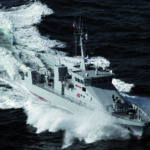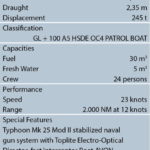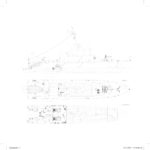It is a rather special event in a captain’s as well as a ship’s lifespan when a new build is sailed some thousand miles from the yard to its home port instead of being shipped by a cargo vessel. A field report about a six week journey with Fassmer’s CPV 40 by John Pardo
Thinking of crossing the Atlantic, travelling around 7,500 NM in a ship of 40 m in length is something that generates[ds_preview] many concerns. The same as I had once heard, I found out when I was appointed Commander of the »ARC 11 de Noviembre« and my first operation led this ship from Bremen, Germany, to Cartagena, Colombia, with a crew of six officers, including myself, and 18 sailors.
The first thing that came to my mind before preparing this voyage was the need for a ship that provides us confidence and security, capable of withstanding weather and sea conditions that would be present during this journey. The opportunity to participate in the construction of the ship at the Fassmer shipyard allowed me to realize the high standards and outstanding quality with which they work and hence I was convinced that we had found the right answer to the initial question: »This ship will have the ability to cross the Atlantic.«
The integral approach subsequently went on to determine what would be the route to be chosen to reach Cartagena, knowing that we had a constraint for legs of no more than 1,600 NM, considering safety margins.
Finding a route across the Atlantic Ocean
Two options were left as the most likely ones. One route started in Bremen, played Lisbon as a first port and subsequently jumped to the Azores Islands, arriving at the port of Orta. Afterwards, Halifax in Canada would be next followed by a southward course to reach Cartagena, passing through the ports of Alexandria and Miami in the United States.
The second route also began with Lisbon as the first port and then continued down to Mindelo in Cape Verde Islands. Afterwards, we would do the Atlantic crossing to Brazil reaching Fortaleza and later Belem. Finally, a stop-over in Paradise Island of Barbados as the last port before arrival in Cartagena was considered.
My initial intention before entering into deeper analysis of the routes was to choose the North Path. It seemed to be more attractive with more developed and prepared ports for the logistical requirements and a better choice from the crew cultural exchange point of view.
I started to investigate what the North Atlantic crossing means for vessels of this type. Current against our course and cold fronts moving from West to East were the first aspects that I found and which did not favor my initial intention. Finally, I met with an experienced captain who had made this crossing on several occasions in order to hear his recommendations and so be able to make the best decision. After a very productive conversation, in which his last sentence was: »I emphatically recommend not go to the North«, there was nothing more to think or analyze. Lisbon, Mindelo, Fortaleza, Belem and Bridgetown would be our ports.
On 1 April 2011 three officers and thirteen sailors that had been selected to complete the crew of the »ARC 11 de Noviembre« arrived in Germany. It was an excellent selection made by my institution to man this new ship. We had forty days to train, know each other and respond as a single team. On 9 May 2011, while the Ambassador of Colombia was present in Germany as well as Mrs. Victoria Mejía, the Head of Planning of the Armada Nacional, Vice-Admiral Roberto Garcia Marquez and the Managing Director of Fassmer, Harald Fassmer, the vessel was delivered by the shipyard to the Colombian Navy and in a military ceremony the flag of the Republic of Colombia was raised atop her main mast.
Crew, supplies and equipment were ready and in accordance with the order we received. We sailed out from Motzen on 10 May 2011 at 18:00 through the Weser River into the North Atlantic for Cartagena on a journey of 7,320 NM which we had planned to manage in 40 days – 28 sailing and 12 in port.
Our first expectation was to meet with the traffic separation scheme that begins at the exit of the Weser River and that would lead us to the crossing of the English Channel. We had been told much about this part of the journey: adverse conditions, permanent traffic and the risk to stop waiting for good weather. To our surprise and due to good fortune, the conditions could not have been better. The sea looked like a mirror. Almost zero wind and traffic was not dense. This indicated a very good start and that surely a bright star would continue to be illuminating our voyage.
Next was the Bay of Biscay, another area where we expected some difficulties. Once we entered the Gulf, total wonder, calm conditions were present, and we could move forward at 14 kn without any setback. This leg from Bremen to Lisbon was planned in five days at an average speed of advance of 11 kn. We had completed already 60 % when we received the weather report on the morning of Friday, 13 May, which showed the formation of bad conditions from Saturday at the head of Cape Finisterre with winds of 35 kn and wave height of 3 to 5 m. Even though we increased speed, we would meet with these bad conditions. Finally, on this Saturday we were changing course to the South, as planned, facing winds that reached 30 kn and waves of up to 3.5 m. A wave hit us on starboard side which made the ship roll dramatically experiencing 35° list. Finally, on 15 May, as scheduled, we arrived to Docas de Alcántara in Lisbon.
Luckily through the hurricane season
After three good days in harbour we sailed bound for Mindelo in Cape Verde on 18 May. During these six days of navigation, we had wonderful conditions: Current and waves by our stern, average visibility of 11 NM and winds that did not exceed 15 kn. These were days that allowed us to complete important administrative work. At sea one never knows when it will be possible to sit in front a computer without the discomfort produced by the movement of the ship. So you should take advantage of this situation every time you can. Finally, on 24 May we arrived to the harbour of Mindelo. There we met »ARC Providencia«, a research vessel of the Colombian Navy which had been assigned to accompany us in the remainder of the path.
On 26 May we started the voyage across the Atlantic with »ARC Providencia« in a tour of 1,449 NM, which lasted for six days of navigation. As most of our journey, the conditions remained excellent. The hurricane season which coincidentally crosses this area had not begun. So, five days without any setback followed until 31 May, when in contrast to the forecasts the wind increased to 35 kn and the waves were about 4 m high. The direction of the wind and sea was south. According to the planned track we had to follow a 240° course here, but under the given sea conditions we had to follow a 275° course to keep reasonable movement, as we experienced up to 40° list and strong breakers. We had to set the course 30° away from the path that would lead us on the shortest way to Fortaleza. Every time we could we maneuvered closer to the 240° course, but due to heavy sea we preferred to wait until conditions improved. At dawn on 1 June 2011 conditions had improved somewhat and we decided to head to port at maximum permitted speed. For almost five hours our ship was sailing through the battering sea, with high combined pitch and roll motions. Finally, around noon we reached the Port of Fortaleza, without any damages or injuries.
After these two hard days, we enjoyed for three days what Fortaleza has to offer. Then we took what we called the »downhill part of the voyage«. We had already passed the toughest legs, and completed about 65 % of the tour. So we needed only 14 days more to get home.
On 7 June we reached the port of Belem in Brazil. Two days later we sailed towards our last port on the island of Barbados: Bridgetown. These voyages were characterized by good conditions. Winds and waves astern helped us home. On 15 June 2011 we sailed towards Cartagena, filled with great expectations and the prospect of seeing our families in a few days. On 20 June, according to our plan, »ARC 11 de Noviembre« docked at the pier of the ARC Bolívar Naval Base in Cartagena. We felt immensely satisfied having completed the voyage across the Atlantic without any setbacks and within a total of 7,320 NM. On that day, our crew and vessel, with God’s help, completed the first operation commissioned to us without any problem respective personnel or material.
John Pardo






















